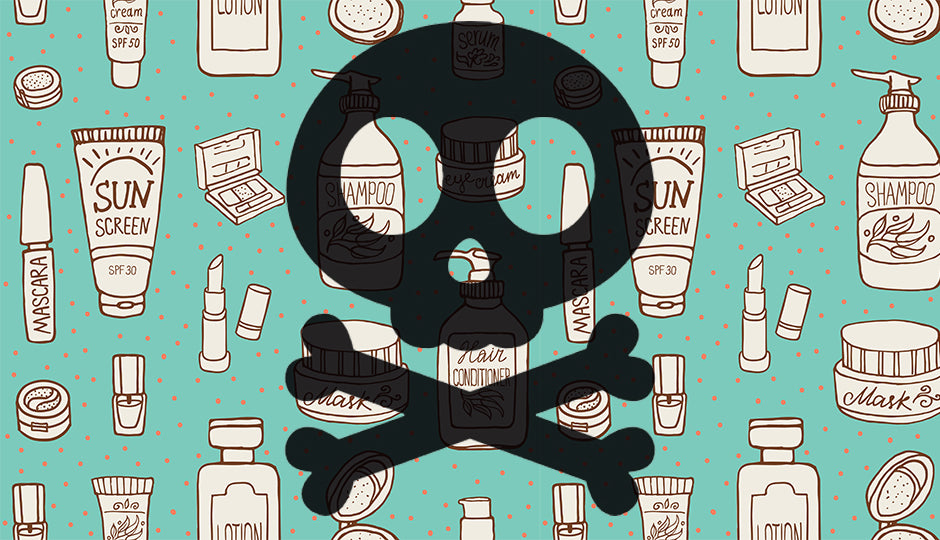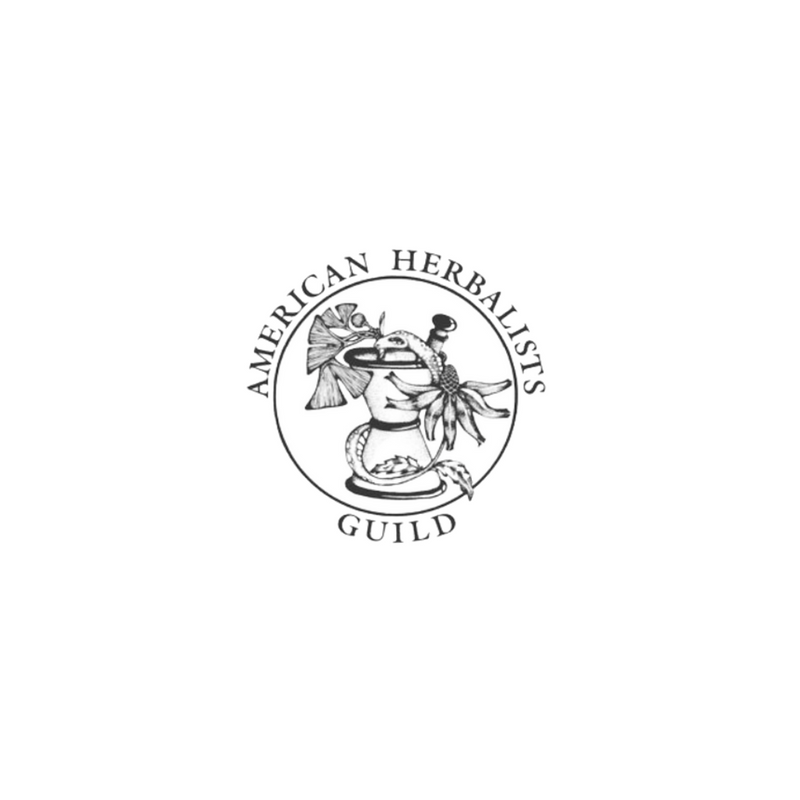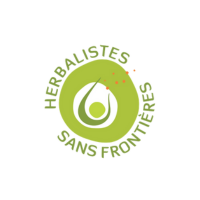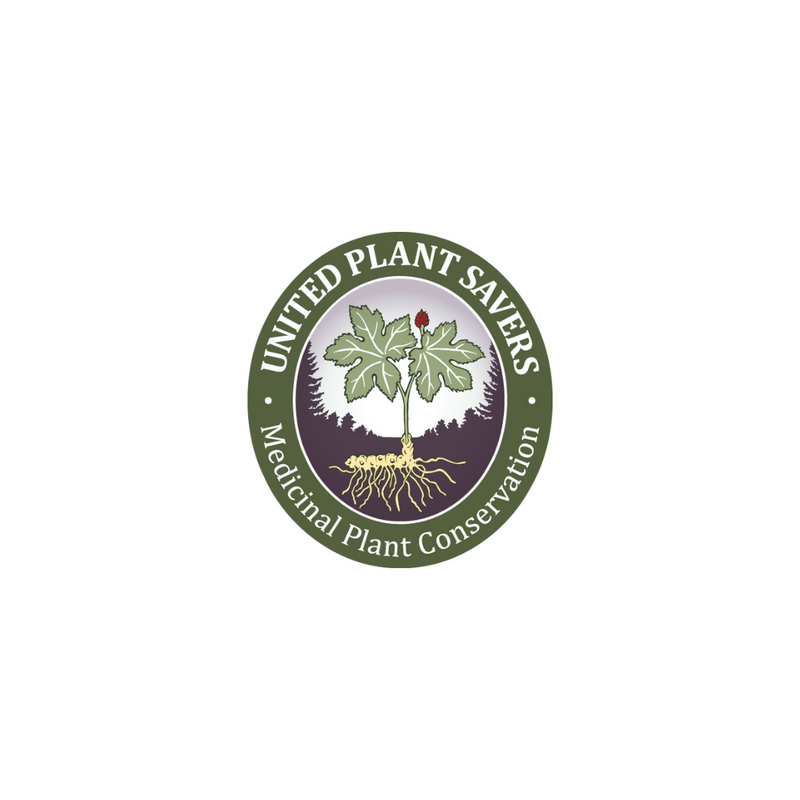
Skin Care and the Products We Choose, Part Two
Share
In part one of this series, we talked about what types of ingredients we do use in our formulas (organic, ethical, pronounceable, and effective remedies, tonics, and body care).
This post is going to talk about what ingredients you should avoid if you wish to avoid ingesting toxins through the skin. As profiled in the last blog post, you need to avoid toxins that have a molecular weight lower than 750 to avoid absorbing the toxin.
FD & C Colors/Pigments:
 These are synthetic colors made from coal and tar. Side effects range from skin irritation, to oxygen depletion, and even death. All those colors that have been tested have shown to be carcinogenic. Molecular Weight: 792.84
These are synthetic colors made from coal and tar. Side effects range from skin irritation, to oxygen depletion, and even death. All those colors that have been tested have shown to be carcinogenic. Molecular Weight: 792.84
Talc:
 It's in baby powder, it can't be that bad, right? Wrong. (And for the record, it is often in mineral cosmetics, eyeshadow, and body powders, too.) Environment Canada (the EPA of Canada) has talc on its list of ingredients "expected to be toxic or harmful". Why? It's known to cause ovarian cancer. Molecular Weight: 379.2657
It's in baby powder, it can't be that bad, right? Wrong. (And for the record, it is often in mineral cosmetics, eyeshadow, and body powders, too.) Environment Canada (the EPA of Canada) has talc on its list of ingredients "expected to be toxic or harmful". Why? It's known to cause ovarian cancer. Molecular Weight: 379.2657
Polyethelene Glycol:
 This contains ethylene oxide, which in very small concentrations cause uterine and breast cancers. The products it is most commonly found in are baby products, women's personal care products, and sunscreen.
This contains ethylene oxide, which in very small concentrations cause uterine and breast cancers. The products it is most commonly found in are baby products, women's personal care products, and sunscreen.
Molecular weight of this product varies with application from 300-6000.
Phthalates:
 These are endocrine disrupting chemicals used as preservatives in many personal care and cosmetic products. They mess with your hormones: they have been linked to early breast development in boys and girls, cause birth defects and low sperm count. Read more about phthalates here.
These are endocrine disrupting chemicals used as preservatives in many personal care and cosmetic products. They mess with your hormones: they have been linked to early breast development in boys and girls, cause birth defects and low sperm count. Read more about phthalates here.
Molecular weight 300-600 is typical.
(So-called) Fragrance:
 By law, phthalates must be put on the label as such if they make up 20% or more of the ingredients. Unless, of course, they are part of a "fragrance". Fragrance does not have to list any ingredients at all. If your product simply lists "fragrance" without disclosing the ingredients of that fragrance, you may be getting a very high and undisclosed toxic load.
By law, phthalates must be put on the label as such if they make up 20% or more of the ingredients. Unless, of course, they are part of a "fragrance". Fragrance does not have to list any ingredients at all. If your product simply lists "fragrance" without disclosing the ingredients of that fragrance, you may be getting a very high and undisclosed toxic load.
We cannot give you a molecular weight without knowing actual ingredients, and by law, a company does not have to give one.
Siloxanes and methicones (these products have ingredients that end with -siloxane or -methicone as part of the word):
 These are used as moisturizers in hair and beauty products and are endocrine disruptors that are linked to infertility and uterine tumors. They are also not biodegradable.
These are used as moisturizers in hair and beauty products and are endocrine disruptors that are linked to infertility and uterine tumors. They are also not biodegradable.
Molecular Weight: varies based on which formulation, but 300-600 is typical in cosmetic applications.
DEA (diethanolamine), MEA (monoethanolamine), & TEA (triethanolmine):
 These are hormone-disrupting chemicals known to form nitrates and nitrosamines, often in conjunction with other chemicals present in a product (cocamide DEA, or lauramide DEA). They are almost always in products that foam: bubble bath, body wash, shampoo, soap, facial cleanser. All three of these chemicals are hormone disruptors that are linked to cancer. Research indicates a strong link to kidney and liver cancer.
These are hormone-disrupting chemicals known to form nitrates and nitrosamines, often in conjunction with other chemicals present in a product (cocamide DEA, or lauramide DEA). They are almost always in products that foam: bubble bath, body wash, shampoo, soap, facial cleanser. All three of these chemicals are hormone disruptors that are linked to cancer. Research indicates a strong link to kidney and liver cancer.
Molecular weight of DEA: 105.14
Molecular weight of MEA: 61.08
Molecular wight of TEA: 149.188
Parabens:
 These are those ingredients that start with methyl, ethyl, propyl, and butyl in their names. These are found in 90% of personal body care products on the market today. 90% of the breast cancers that have been sampled have paraben esters present. You read that right. The vast majority of body care available in the US have strong links to breast cancer. These are in anti-perspirants and shampoos and much more.
These are those ingredients that start with methyl, ethyl, propyl, and butyl in their names. These are found in 90% of personal body care products on the market today. 90% of the breast cancers that have been sampled have paraben esters present. You read that right. The vast majority of body care available in the US have strong links to breast cancer. These are in anti-perspirants and shampoos and much more.
Molecular weights range from: 152.15 to 194.23.
Propylene Glycol:
 Colorless and odorless, it is used in massage oils and deodorants and... anti-freeze. If the EPA recommends gloves and goggles to anyone handling this ingredient in the workplace, should you be putting it on your skin?
Colorless and odorless, it is used in massage oils and deodorants and... anti-freeze. If the EPA recommends gloves and goggles to anyone handling this ingredient in the workplace, should you be putting it on your skin?
Implicated in contact dermatitis, kidney damage and liver abnormalities; can inhibit cell growth in human tests and can damage membranes causing rashes, dry skin and surface damage. May be harmful by inhalation, ingestion or skin absorption. May cause eye irritation. Exposure can cause gastro-intestinal disturbances, nausea, headache and vomiting, central nervous system depression. (Material Safety Data Sheets)
Propylene Glycol causes a significant number of reactions and was a primary irritant to the skin in low levels of concentrations. -The American Academy of Dermatologists, January 1991
Molecular weight: 76.09
Mineral Oil:
 Hilarious that both mineral oil and talc are on this list. Advertising at its worst. The original baby oil, right? What could be bad about this? Actually, this is classified as a skin irritant by the EPA and comes from petroleum. It contains PAHs (polycydic aromatic hydrocarbons), which can cause cancer.
Hilarious that both mineral oil and talc are on this list. Advertising at its worst. The original baby oil, right? What could be bad about this? Actually, this is classified as a skin irritant by the EPA and comes from petroleum. It contains PAHs (polycydic aromatic hydrocarbons), which can cause cancer.
A molecular weight cannot be determined, because there are many formulas to make a mineral oil.
Sodium Laurel Sulfate (SLS) (Also known as sodium dodecyl sulphate, dodecyl sodium sulphate, lauryl sodium sulphate, sodium laurylsulphate, sodium lauryl sulfate, sulphuric acid, monododecyl ester, sodium salt):
 This is another ingredient in 90% of personal care products found in the United States! Known side effects include: depression, breathing difficulty, diarrhea, skin irritation, and death.
This is another ingredient in 90% of personal care products found in the United States! Known side effects include: depression, breathing difficulty, diarrhea, skin irritation, and death.
It's in so may US shampoos, liquid soaps and bubble baths, and toothpastes that many just assume it is safe. It's not a major ingredient in other countries and here is some science warning us away:
SLS can damage the immune system; causing separation of skin layers and inflammation of skin. --Journal of the American College of Toxicology; Vol. 2, No. 7, 1983
To prevent canker sores, avoid Sodium Lauryl Sulfate (SLS) which is often used in toothpaste. --Brad Rodu, DDS, Oral Pathologist, University of Alabama At Birmingham School Of Medicine, in "BottomLine Personal"
"Sodium lauryl sulfate (SLS), the most widely used detergent in toothpastes, has been reported to cause adverse effects on oral soft tissues. This double-blind cross-over study indicates that sensitive patients may contract mucosal irritation through SLS in toothpastes. Less toxic detergents,..,are desirable in oral hygiene products." --Herlofson BB, Barkvoll P., Department of Oral Surgery and Oral Medicine, Dental School, University of Oslo, Norway. "Oral Mucosal Desquamation Caused By Two Toothpaste Detergents In An Experimental Model," Eur J Oral Sci 1996 Feb
SLS denatures proteins of eye tissues - impairing eye development permanently. --Dr. Keith Green, PHD, D.Sc., Medical College of Georgia
SLS is a mutagen. It is capable of changing the information in genetic material found in cells. SLS has been used in studies to induce mutagen in bacteria. --Higuchi, Araya and Higuchi, School of Medicine, Tohoku University: Sendai 980 Japan
The molecular weight of SLS is 288.38 which can easily pass into the cells. In studies, it has been found lodged in the heart, lungs, liver and brain up to five days after initial exposure. Seeing as we have multiple exposures a day, SLS accumulates and is constantly present until we stop using products containing it. In fact, SLS is often added to medicines to transport the active ingredients into the body.
Aspartame:
 is an artificial sweetener found in an ever-increasing number of foods and toothpastes consumed by adults and children alike. Over 75% of the adverse reactions to food additives reported to the US Food and Drug Administration (FDA) are due to aspartame. Many of these reactions are very serious, resulting in seizures and death and worsen or create dozens of other conditions such as migraines, muscle spasms, MS, fibromyalgia, and diabetes.
is an artificial sweetener found in an ever-increasing number of foods and toothpastes consumed by adults and children alike. Over 75% of the adverse reactions to food additives reported to the US Food and Drug Administration (FDA) are due to aspartame. Many of these reactions are very serious, resulting in seizures and death and worsen or create dozens of other conditions such as migraines, muscle spasms, MS, fibromyalgia, and diabetes.
Molecular Weight: 294.3
Fluoride:
 Sodium Fluoride (NaF), a constituent of most toothpastes, has been used as the active ingredient in insecticides, wood preservatives, fungicides and rat poison. It works on rats by causing lesions in their stomachs (which eventually result in the rat bleeding to death). So why would we put this in our mouth and possibly swallow it?
Sodium Fluoride (NaF), a constituent of most toothpastes, has been used as the active ingredient in insecticides, wood preservatives, fungicides and rat poison. It works on rats by causing lesions in their stomachs (which eventually result in the rat bleeding to death). So why would we put this in our mouth and possibly swallow it?
If you have children, you probably find it difficult to stop them from ingesting some of their toothpaste, especially as it has been made to be tasty to encourage brushing. But what could it be doing to their bodies?
In 1998, Dr A K Susheela of the India Institute of Medical Sciences in New Delhi, presented a report of her research entitled "Scientific Evidence On Adverse Effects Of Fluoride" to MPs in Westminster. She discovered that "fluoride from these toothpastes enters the circulation within minutes".
Given the evidence of how toxic this product can be, this is troublesome:
In 1992 a randomized double-blind study was conducted in which healthy male volunteers were given either sodium fluoride or sodium monofluorophosphate (MFP) tablets (both common ingredients in toothpaste) for seven days.
Before the trial, both sets of volunteers had their stomach linings assessed. This was repeated again at the end of the trial. Those in the MFP group showed no significant changes but seven out of ten in the Sodium Fluoride group had significant stomach lesions, including acute haemorrhages and free blood in their stomachs. (Gastroenterology 1992; 30: 252-4)
Sodium Fluoride is a hazardous waste by-product from the aluminum smelting process. It can also be derived from the pollution scrubbers of the phosphate fertilizer industry. This by-product is too toxic to be dumped in the environment and it is classified as a poison. It is found in toothpastes in concentrations of up to 1500 parts per million (ppm).
Molecular Weight: 18.9984
Rest assured, we never include any of these products in Haven Herbs products and continue to educate ourselves on ingredients and the body care industry to educate others about good choices.
This post is going to talk about what ingredients you should avoid if you wish to avoid ingesting toxins through the skin. As profiled in the last blog post, you need to avoid toxins that have a molecular weight lower than 750 to avoid absorbing the toxin.
FD & C Colors/Pigments:
 These are synthetic colors made from coal and tar. Side effects range from skin irritation, to oxygen depletion, and even death. All those colors that have been tested have shown to be carcinogenic. Molecular Weight: 792.84
These are synthetic colors made from coal and tar. Side effects range from skin irritation, to oxygen depletion, and even death. All those colors that have been tested have shown to be carcinogenic. Molecular Weight: 792.84Talc:
 It's in baby powder, it can't be that bad, right? Wrong. (And for the record, it is often in mineral cosmetics, eyeshadow, and body powders, too.) Environment Canada (the EPA of Canada) has talc on its list of ingredients "expected to be toxic or harmful". Why? It's known to cause ovarian cancer. Molecular Weight: 379.2657
It's in baby powder, it can't be that bad, right? Wrong. (And for the record, it is often in mineral cosmetics, eyeshadow, and body powders, too.) Environment Canada (the EPA of Canada) has talc on its list of ingredients "expected to be toxic or harmful". Why? It's known to cause ovarian cancer. Molecular Weight: 379.2657Polyethelene Glycol:
 This contains ethylene oxide, which in very small concentrations cause uterine and breast cancers. The products it is most commonly found in are baby products, women's personal care products, and sunscreen.
This contains ethylene oxide, which in very small concentrations cause uterine and breast cancers. The products it is most commonly found in are baby products, women's personal care products, and sunscreen. Molecular weight of this product varies with application from 300-6000.
Phthalates:
 These are endocrine disrupting chemicals used as preservatives in many personal care and cosmetic products. They mess with your hormones: they have been linked to early breast development in boys and girls, cause birth defects and low sperm count. Read more about phthalates here.
These are endocrine disrupting chemicals used as preservatives in many personal care and cosmetic products. They mess with your hormones: they have been linked to early breast development in boys and girls, cause birth defects and low sperm count. Read more about phthalates here.Molecular weight 300-600 is typical.
(So-called) Fragrance:
 By law, phthalates must be put on the label as such if they make up 20% or more of the ingredients. Unless, of course, they are part of a "fragrance". Fragrance does not have to list any ingredients at all. If your product simply lists "fragrance" without disclosing the ingredients of that fragrance, you may be getting a very high and undisclosed toxic load.
By law, phthalates must be put on the label as such if they make up 20% or more of the ingredients. Unless, of course, they are part of a "fragrance". Fragrance does not have to list any ingredients at all. If your product simply lists "fragrance" without disclosing the ingredients of that fragrance, you may be getting a very high and undisclosed toxic load. We cannot give you a molecular weight without knowing actual ingredients, and by law, a company does not have to give one.
Siloxanes and methicones (these products have ingredients that end with -siloxane or -methicone as part of the word):
Molecular Weight: varies based on which formulation, but 300-600 is typical in cosmetic applications.
DEA (diethanolamine), MEA (monoethanolamine), & TEA (triethanolmine):
 These are hormone-disrupting chemicals known to form nitrates and nitrosamines, often in conjunction with other chemicals present in a product (cocamide DEA, or lauramide DEA). They are almost always in products that foam: bubble bath, body wash, shampoo, soap, facial cleanser. All three of these chemicals are hormone disruptors that are linked to cancer. Research indicates a strong link to kidney and liver cancer.
These are hormone-disrupting chemicals known to form nitrates and nitrosamines, often in conjunction with other chemicals present in a product (cocamide DEA, or lauramide DEA). They are almost always in products that foam: bubble bath, body wash, shampoo, soap, facial cleanser. All three of these chemicals are hormone disruptors that are linked to cancer. Research indicates a strong link to kidney and liver cancer.Molecular weight of DEA: 105.14
Molecular weight of MEA: 61.08
Molecular wight of TEA: 149.188
Parabens:
 These are those ingredients that start with methyl, ethyl, propyl, and butyl in their names. These are found in 90% of personal body care products on the market today. 90% of the breast cancers that have been sampled have paraben esters present. You read that right. The vast majority of body care available in the US have strong links to breast cancer. These are in anti-perspirants and shampoos and much more.
These are those ingredients that start with methyl, ethyl, propyl, and butyl in their names. These are found in 90% of personal body care products on the market today. 90% of the breast cancers that have been sampled have paraben esters present. You read that right. The vast majority of body care available in the US have strong links to breast cancer. These are in anti-perspirants and shampoos and much more.Molecular weights range from: 152.15 to 194.23.
Propylene Glycol:
 Colorless and odorless, it is used in massage oils and deodorants and... anti-freeze. If the EPA recommends gloves and goggles to anyone handling this ingredient in the workplace, should you be putting it on your skin?
Colorless and odorless, it is used in massage oils and deodorants and... anti-freeze. If the EPA recommends gloves and goggles to anyone handling this ingredient in the workplace, should you be putting it on your skin?Implicated in contact dermatitis, kidney damage and liver abnormalities; can inhibit cell growth in human tests and can damage membranes causing rashes, dry skin and surface damage. May be harmful by inhalation, ingestion or skin absorption. May cause eye irritation. Exposure can cause gastro-intestinal disturbances, nausea, headache and vomiting, central nervous system depression. (Material Safety Data Sheets)
Propylene Glycol causes a significant number of reactions and was a primary irritant to the skin in low levels of concentrations. -The American Academy of Dermatologists, January 1991
Molecular weight: 76.09
Mineral Oil:
 Hilarious that both mineral oil and talc are on this list. Advertising at its worst. The original baby oil, right? What could be bad about this? Actually, this is classified as a skin irritant by the EPA and comes from petroleum. It contains PAHs (polycydic aromatic hydrocarbons), which can cause cancer.
Hilarious that both mineral oil and talc are on this list. Advertising at its worst. The original baby oil, right? What could be bad about this? Actually, this is classified as a skin irritant by the EPA and comes from petroleum. It contains PAHs (polycydic aromatic hydrocarbons), which can cause cancer.A molecular weight cannot be determined, because there are many formulas to make a mineral oil.
Sodium Laurel Sulfate (SLS) (Also known as sodium dodecyl sulphate, dodecyl sodium sulphate, lauryl sodium sulphate, sodium laurylsulphate, sodium lauryl sulfate, sulphuric acid, monododecyl ester, sodium salt):
 This is another ingredient in 90% of personal care products found in the United States! Known side effects include: depression, breathing difficulty, diarrhea, skin irritation, and death.
This is another ingredient in 90% of personal care products found in the United States! Known side effects include: depression, breathing difficulty, diarrhea, skin irritation, and death.It's in so may US shampoos, liquid soaps and bubble baths, and toothpastes that many just assume it is safe. It's not a major ingredient in other countries and here is some science warning us away:
SLS can damage the immune system; causing separation of skin layers and inflammation of skin. --Journal of the American College of Toxicology; Vol. 2, No. 7, 1983
To prevent canker sores, avoid Sodium Lauryl Sulfate (SLS) which is often used in toothpaste. --Brad Rodu, DDS, Oral Pathologist, University of Alabama At Birmingham School Of Medicine, in "BottomLine Personal"
"Sodium lauryl sulfate (SLS), the most widely used detergent in toothpastes, has been reported to cause adverse effects on oral soft tissues. This double-blind cross-over study indicates that sensitive patients may contract mucosal irritation through SLS in toothpastes. Less toxic detergents,..,are desirable in oral hygiene products." --Herlofson BB, Barkvoll P., Department of Oral Surgery and Oral Medicine, Dental School, University of Oslo, Norway. "Oral Mucosal Desquamation Caused By Two Toothpaste Detergents In An Experimental Model," Eur J Oral Sci 1996 Feb
SLS denatures proteins of eye tissues - impairing eye development permanently. --Dr. Keith Green, PHD, D.Sc., Medical College of Georgia
SLS is a mutagen. It is capable of changing the information in genetic material found in cells. SLS has been used in studies to induce mutagen in bacteria. --Higuchi, Araya and Higuchi, School of Medicine, Tohoku University: Sendai 980 Japan
The molecular weight of SLS is 288.38 which can easily pass into the cells. In studies, it has been found lodged in the heart, lungs, liver and brain up to five days after initial exposure. Seeing as we have multiple exposures a day, SLS accumulates and is constantly present until we stop using products containing it. In fact, SLS is often added to medicines to transport the active ingredients into the body.
Aspartame:
 is an artificial sweetener found in an ever-increasing number of foods and toothpastes consumed by adults and children alike. Over 75% of the adverse reactions to food additives reported to the US Food and Drug Administration (FDA) are due to aspartame. Many of these reactions are very serious, resulting in seizures and death and worsen or create dozens of other conditions such as migraines, muscle spasms, MS, fibromyalgia, and diabetes.
is an artificial sweetener found in an ever-increasing number of foods and toothpastes consumed by adults and children alike. Over 75% of the adverse reactions to food additives reported to the US Food and Drug Administration (FDA) are due to aspartame. Many of these reactions are very serious, resulting in seizures and death and worsen or create dozens of other conditions such as migraines, muscle spasms, MS, fibromyalgia, and diabetes.Molecular Weight: 294.3
Fluoride:
 Sodium Fluoride (NaF), a constituent of most toothpastes, has been used as the active ingredient in insecticides, wood preservatives, fungicides and rat poison. It works on rats by causing lesions in their stomachs (which eventually result in the rat bleeding to death). So why would we put this in our mouth and possibly swallow it?
Sodium Fluoride (NaF), a constituent of most toothpastes, has been used as the active ingredient in insecticides, wood preservatives, fungicides and rat poison. It works on rats by causing lesions in their stomachs (which eventually result in the rat bleeding to death). So why would we put this in our mouth and possibly swallow it?If you have children, you probably find it difficult to stop them from ingesting some of their toothpaste, especially as it has been made to be tasty to encourage brushing. But what could it be doing to their bodies?
In 1998, Dr A K Susheela of the India Institute of Medical Sciences in New Delhi, presented a report of her research entitled "Scientific Evidence On Adverse Effects Of Fluoride" to MPs in Westminster. She discovered that "fluoride from these toothpastes enters the circulation within minutes".
Given the evidence of how toxic this product can be, this is troublesome:
In 1992 a randomized double-blind study was conducted in which healthy male volunteers were given either sodium fluoride or sodium monofluorophosphate (MFP) tablets (both common ingredients in toothpaste) for seven days.
Before the trial, both sets of volunteers had their stomach linings assessed. This was repeated again at the end of the trial. Those in the MFP group showed no significant changes but seven out of ten in the Sodium Fluoride group had significant stomach lesions, including acute haemorrhages and free blood in their stomachs. (Gastroenterology 1992; 30: 252-4)
Sodium Fluoride is a hazardous waste by-product from the aluminum smelting process. It can also be derived from the pollution scrubbers of the phosphate fertilizer industry. This by-product is too toxic to be dumped in the environment and it is classified as a poison. It is found in toothpastes in concentrations of up to 1500 parts per million (ppm).
Molecular Weight: 18.9984
Rest assured, we never include any of these products in Haven Herbs products and continue to educate ourselves on ingredients and the body care industry to educate others about good choices.





2 comments
You are most welcome, Amanda. We consider education one of the main things that we do here at Haven. We value your safety and health!
Thanks for all of the information about these ingredients. It’s often difficult to find unbiased information about the chemicals and ingredients in personal care products. But I do feel so much better just avoiding them all.